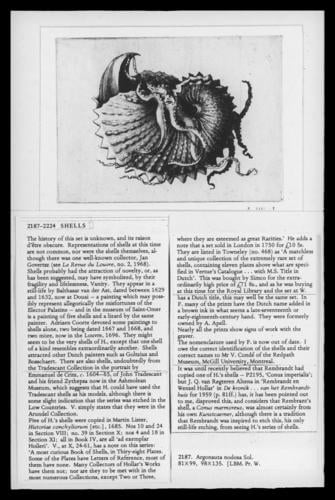Nodose or knobbly paper nautilus (Argonauta nodosa Lightfoot, 1786) c.1645
Etching | 9.8 x 13.4 cm (sheet of paper) | RCIN 804563

Wenceslaus Hollar (1607-77)
Nodose or knobbly paper nautilus (Argonauta nodosa Lightfoot, 1786) c.1645

Wenceslaus Hollar (1607-77)
Nodose or knobbly paper nautilus (Argonauta nodosa Lightfoot, 1786) c.1645


-
An etching of a paper nautilus, with tentacles spreading from its calcareous 'shell': Nodose or knobbly paper nautilus, Argonauta nodosa Lightfoot, 1786 (syn. A. tuberculata Röding, 1798, Parthey’s identification) [Argonautidae; A&D p. 376]. Indo-Pacific, typically 100-150 mm. The paper nautiluses are not true shells but the eggcase of an octopus. While the morphology of the beaked ‘face’ peering over the edge of the shell is fanciful, the general concept is sound – there are eight distinct tentacles – suggesting that Hollar was working from a preserved specimen. Buonanni (1.I.13) illustrated the shell only of the common paper nautilus (A. argo Linnaeus, 1758), not modelled on Hollar’s print.***
Wenceslaus Hollar's etchings of shells are the finest depictions of shells of their period. [Note: none of the prints is signed, and there is no document that identifies Hollar as the printmaker. The style seems securely his, but the quality and sensitivity of the etchings may seem somewhat surprising in Hollar's oeuvre, which rarely rose above the workmanlike.] The only substantial error is that Hollar omitted to take account of the reversal of the printed image, such that all of the shells in the etchings spiral sinistrally, ie. in the wrong direction.
Most of the shells are tropical gastropods; there are also one bivalve, the shell of a giant Ghana land snail, and a paper nautilus (not a true shell, but the eggcase of an octopus). Some are from the Caribbean, but most are from the Indo-Pacific. By the middle of the seventeenth century traders from the Low Countries had established networks of colonies, ports and suppliers throughout much of south-east Asia (the ‘Dutch East Indies’), and the shells had presumably been brought back to Antwerp by traders and explorers to form part of an unknown collector’s ‘cabinet of curiosities’. Two of the largest of the shells depicted (the giant baler, to 45cm/18”, and the Australian trumpet, which can reach lengths of 80cm/30”) are from as far afield as Australia; although Dutch explorers had reached the northern coasts of Australia by this date, these spectacular (and useful) shells may well have been traded locally across south-east Asia and picked up by a trader far from their original source.
Most of the species are common in their areas of distribution, and were known in Europe in the 17th and 18th centuries. Most were described by Carl Linnaeus in the definitive 10th edition of his Systema Naturae of 1758; Linnaeus’s binomials remain the accepted scientific names for most of the species depicted.
The ‘common names’ are more problematic. While some are in general use, such as tiger cowrie for Cypraea tigris (which however is spotted rather than striped!), most ‘common names’ for non-European species are the inventions of nineteenth- or twentieth-century conchologists, and there can be many different names in circulation for a single species (just the confusion that Linnaeus’s binomial system was intended to resolve). The common names given here are therefore those found in the best generally available compendium of seashells, R.T. Abbott and S.P. Dance, Compendium of Seashells, New York 1982 and later editions.
The distributions and sizes are taken mainly from the very useful website www.gastropods.com, where good colour photographs of specimens of most of the shells depicted by Hollar may be found. Unless otherwise noted, the identifications agree with those in Parthey and Pennington.
Most of the etchings were copied in Filippo Buonanni’s Recreatione dell’occhio e delle mente nell’osservation’ delle chiocciole, published in 1681; the Latin edition of 1684 added a further 87 images, none of which were derived from the Hollar series.
Martin Clayton, Dec 2014.
Provenance
Probably acquired during the seventeenth or eighteenth century
-
Creator(s)
-
Medium and techniques
Etching
Measurements
9.8 x 13.4 cm (sheet of paper)
Category
Object type(s)







